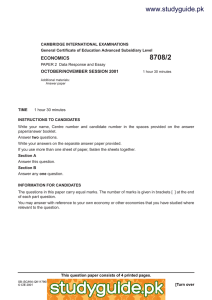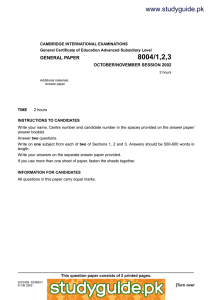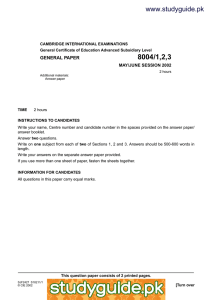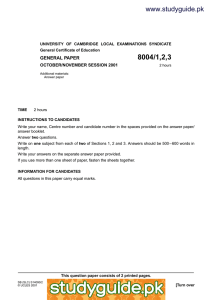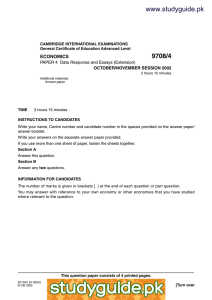www.studyguide.pk
advertisement
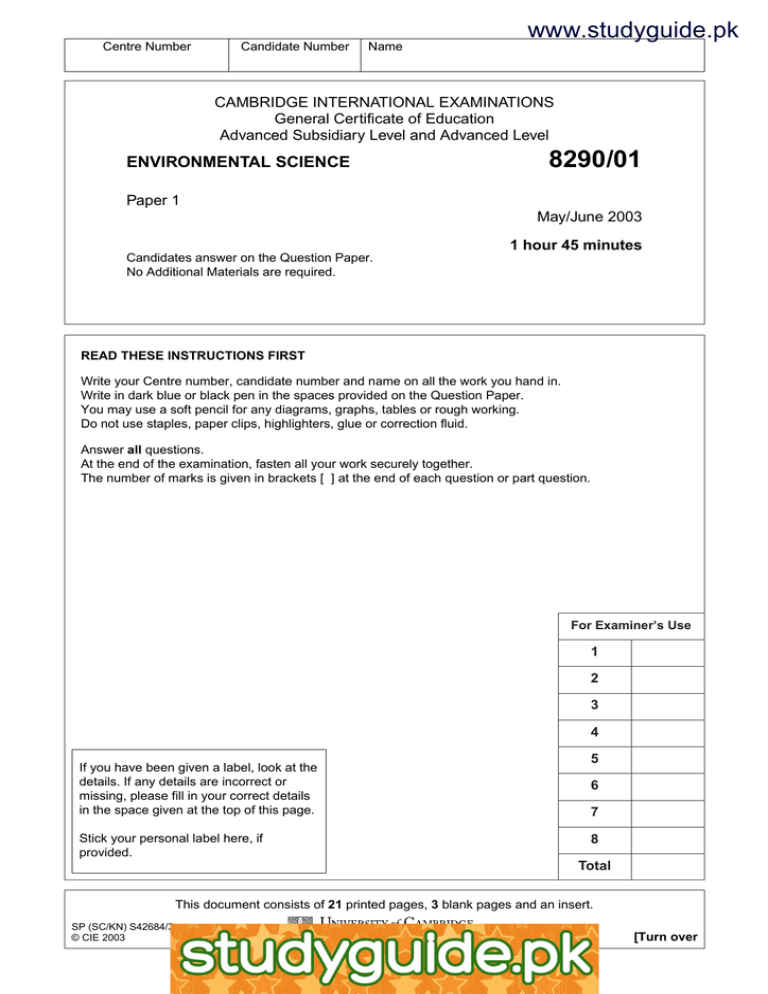
Centre Number Candidate Number Name www.studyguide.pk CAMBRIDGE INTERNATIONAL EXAMINATIONS General Certificate of Education Advanced Subsidiary Level and Advanced Level ENVIRONMENTAL SCIENCE 8290/01 Paper 1 May/June 2003 1 hour 45 minutes Candidates answer on the Question Paper. No Additional Materials are required. READ THESE INSTRUCTIONS FIRST Write your Centre number, candidate number and name on all the work you hand in. Write in dark blue or black pen in the spaces provided on the Question Paper. You may use a soft pencil for any diagrams, graphs, tables or rough working. Do not use staples, paper clips, highlighters, glue or correction fluid. Answer all questions. At the end of the examination, fasten all your work securely together. The number of marks is given in brackets [ ] at the end of each question or part question. For Examiner’s Use 1 2 3 4 If you have been given a label, look at the details. If any details are incorrect or missing, please fill in your correct details in the space given at the top of this page. Stick your personal label here, if provided. 5 6 7 8 Total This document consists of 21 printed pages, 3 blank pages and an insert. SP (SC/KN) S42684/3 © CIE 2003 http://www.xtremepapers.net [Turn over www.studyguide.pk 2 1 Fig. 1.1 shows three areas A, B and C of different surface air pressure in the northern hemisphere. low pressure area A high pressure area B low pressure area C Equato r Fig. 1.1 (a) On Fig. 1.1 use arrows to show the general directions of air movement between (i) areas A and B, (ii) areas B and C. [2] (b) Explain how the direction of air movement between these areas is influenced by the Earth’s rotation. .......................................................................................................................................... .......................................................................................................................................... .......................................................................................................................................... .......................................................................................................................................... ......................................................................................................................................[2] 8290/01/M/J/03 For Examiner’s Use www.studyguide.pk 3 98 8 99 2 Fig. 1.2 shows an outline map of a typical frontal depression, also known as a cyclone. For Examiner’s Use isobars pressure in millibars 984 980 F warm front E cold front Fig. 1.2 (c) Line E to F on Fig. 1.2 is used in Fig. 1.3. Use Fig. 1.3 to construct a cross section through the frontal depression. Label the warm front, the cold front, an area of stratus cloud and an area of cumulo-nimbus cloud. [4] altitude E F Fig. 1.3 (d) Describe the temperature, air pressure and rainfall pattern which would accompany the passage of the cyclonic system shown in Fig. 1.2. temperature ..................................................................................................................... .......................................................................................................................................... .......................................................................................................................................... .......................................................................................................................................... .......................................................................................................................................... 8290/01/M/J/03 [Turn over www.studyguide.pk 4 air pressure ...................................................................................................................... .......................................................................................................................................... .......................................................................................................................................... .......................................................................................................................................... .......................................................................................................................................... rainfall .............................................................................................................................. .......................................................................................................................................... .......................................................................................................................................... .......................................................................................................................................... ......................................................................................................................................[6] 2 Fig. 2.1 shows the Carbon Cycle. atmosphere carbon dioxide combustion and respiration photosynthesis fossil fuel biomass carbonates in solution carbonate rocks biosphere he w e at hydrosphere ring lithosphere Fig. 2.1 8290/01/M/J/03 For Examiner’s Use www.studyguide.pk 5 For Examiner’s Use (a) Explain the meaning of the arrows and labels in Fig. 2.1. .......................................................................................................................................... .......................................................................................................................................... .......................................................................................................................................... .......................................................................................................................................... .......................................................................................................................................... .......................................................................................................................................... .......................................................................................................................................... ......................................................................................................................................[3] (b) Describe how photosynthesis transfers carbon dioxide from the atmosphere to the biomass. .......................................................................................................................................... .......................................................................................................................................... .......................................................................................................................................... .......................................................................................................................................... .......................................................................................................................................... .......................................................................................................................................... .......................................................................................................................................... ......................................................................................................................................[3] (c) Give two reasons why it is important to understand the nature of carbon sinks. 1. ...................................................................................................................................... .......................................................................................................................................... .......................................................................................................................................... 2. ...................................................................................................................................... .......................................................................................................................................... ......................................................................................................................................[2] 8290/01/M/J/03 [Turn over www.studyguide.pk 6 (d) “One hundred and fifty of the world’s major governments met in Kyoto, Japan, to discuss agreements to cut emissions of carbon dioxide, methane, nitrogen oxides, sulphur hexafluoride and hydrofluorocarbons, all important greenhouse gases. Industrialised nations agreed to reduce their emissions of greenhouse gases by, for example: Canada EU Japan USA 6% 8% 6% 7% These must be achieved between 2001 and 2012. The countries that really need to be involved said ‘hell no’ at Kyoto.” Suggest three reasons why many countries of the developed world have found it difficult to meet the requirements of the Kyoto protocol. 1. ...................................................................................................................................... .......................................................................................................................................... .......................................................................................................................................... .......................................................................................................................................... 2. ...................................................................................................................................... .......................................................................................................................................... .......................................................................................................................................... .......................................................................................................................................... 3. ...................................................................................................................................... .......................................................................................................................................... .......................................................................................................................................... ......................................................................................................................................[6] 8290/01/M/J/03 For Examiner’s Use www.studyguide.pk 7 BLANK PAGE Question 3 begins on the next page 8290/01/M/J/03 [Turn over www.studyguide.pk 8 3 The insert provided shows an area of tropical rain forest before and after burning. (a) (i) Describe the structure of vegetation shown in photograph A. .................................................................................................................................. .................................................................................................................................. .................................................................................................................................. .................................................................................................................................. .................................................................................................................................. .................................................................................................................................. .................................................................................................................................. ..............................................................................................................................[3] (ii) Name and explain the role of one abiotic factor important to the vegetation cover shown in photograph A. factor ........................................................................................................................ role ........................................................................................................................... .................................................................................................................................. .................................................................................................................................. .................................................................................................................................. ..............................................................................................................................[3] (b) Photograph B shows the impact of burning on a former area of tropical rain forest. Describe three effects that forest burning could have on the area shown on photograph B. 1. ...................................................................................................................................... .......................................................................................................................................... .......................................................................................................................................... 2. ...................................................................................................................................... .......................................................................................................................................... .......................................................................................................................................... 3. ...................................................................................................................................... .......................................................................................................................................... ......................................................................................................................................[3] 8290/01/M/J/03 For Examiner’s Use www.studyguide.pk 9 (c) Table 3.1 contains data about the production and recycling of plant biomass within two ecosystems For Examiner’s Use Table 3.1 total dry mass/kg m–2 new plant biomass produced per year plant litter produced per year humus content of soil deciduous woodland 0.9 0.5 4.5 tropical rain forest 3.3 2.5 0.2 ecosystem Explain the differences between the two ecosystems in the production of new plant biomass, plant litter and humus. new plant biomass ........................................................................................................... .......................................................................................................................................... .......................................................................................................................................... .......................................................................................................................................... plant litter .......................................................................................................................... .......................................................................................................................................... .......................................................................................................................................... .......................................................................................................................................... humus .............................................................................................................................. .......................................................................................................................................... .......................................................................................................................................... ......................................................................................................................................[3] 8290/01/M/J/03 [Turn over www.studyguide.pk 10 4 Fig. 4.1 shows 6 effects of the Earth’s land surface and atmosphere on incoming and outgoing radiation. 1 2 3 4 5 clouds and greenhouse gases 6 land surface Fig. 4.1 (a) Complete Table 4.1 below by matching the number with the description of the effect. (As guidance number 4 is completed). Table 4.1 description of the effect number The Earth’s surface absorbs incoming radiation. 4 Radiation that is absorbed by the gases in the atmosphere. This warms the atmosphere. 3 As the Earth’s surface is warmed and radiates heat, some of this escapes into space. [3] (b) Explain the processes that are occurring in effects 1 and 6 in Fig. 4.1. effect 1 ............................................................................................................................. .......................................................................................................................................... .......................................................................................................................................... .......................................................................................................................................... .......................................................................................................................................... 8290/01/M/J/03 For Examiner’s Use www.studyguide.pk 11 effect 6 ............................................................................................................................. For Examiner’s Use .......................................................................................................................................... .......................................................................................................................................... .......................................................................................................................................... ......................................................................................................................................[3] (c) Suggest two reasons for the way in which the amount of solar radiation reaching the Earth’s surface varies with latitude. .......................................................................................................................................... .......................................................................................................................................... .......................................................................................................................................... .......................................................................................................................................... .......................................................................................................................................... .......................................................................................................................................... ......................................................................................................................................[2] (d) Explain the meaning of the term albedo. .......................................................................................................................................... .......................................................................................................................................... ......................................................................................................................................[1] (e) Explain why the Earth’s albedo in high latitudes exceeds that in equatorial regions. .......................................................................................................................................... .......................................................................................................................................... .......................................................................................................................................... .......................................................................................................................................... .......................................................................................................................................... .......................................................................................................................................... ......................................................................................................................................[2] 8290/01/M/J/03 [Turn over www.studyguide.pk 12 5 For Examiner’s Use Fig. 5.1 shows thin sections of two sedimentary rocks A and B. A B scale: 30 scale: 30 Fig. 5.1 In both sections the white minerals are quartz and the black minerals are ferro-magnesian. (a) Describe the texture of rock A. .......................................................................................................................................... .......................................................................................................................................... .......................................................................................................................................... .......................................................................................................................................... ......................................................................................................................................[2] (b) Describe the texture of rock B. .......................................................................................................................................... .......................................................................................................................................... .......................................................................................................................................... .......................................................................................................................................... ......................................................................................................................................[2] (c) Describe the types of environment that would produce rocks A and B. rock A .............................................................................................................................. .......................................................................................................................................... .......................................................................................................................................... .......................................................................................................................................... 8290/01/M/J/03 www.studyguide.pk 13 rock B .............................................................................................................................. For Examiner’s Use .......................................................................................................................................... .......................................................................................................................................... ......................................................................................................................................[4] Fig. 5.2 shows a granite intrusion into some sedimentary rocks. shelly limestone shale limestone folded sandstone granite intrusion dyke A dyke B Fig. 5.2 (d) Describe the effect that the intrusion of the granite may have on the nearby sandstone. .......................................................................................................................................... .......................................................................................................................................... .......................................................................................................................................... .......................................................................................................................................... ......................................................................................................................................[2] (e) What effect will the dykes have had upon the limestone and shale in the contact zone either side of each intrusion? limestone ......................................................................................................................... .......................................................................................................................................... shale ................................................................................................................................. ......................................................................................................................................[2] 8290/01/M/J/03 [Turn over www.studyguide.pk 14 6 For Examiner’s Use Fig. 6.1 shows a cross section of an artesian basin. recharge areas bore holes springs mean sea level Key bedrock aquifer direction of water movement impervious material operation of an artesian basin Fig. 6.1 (a) What is groundwater? .......................................................................................................................................... .......................................................................................................................................... .......................................................................................................................................... ......................................................................................................................................[2] (b) Describe the geological conditions that have enabled the development of this artesian basin. .......................................................................................................................................... .......................................................................................................................................... .......................................................................................................................................... .......................................................................................................................................... .......................................................................................................................................... ......................................................................................................................................[3] 8290/01/M/J/03 www.studyguide.pk 15 For Examiner’s Use (c) Why do springs occur in the areas labelled? .......................................................................................................................................... .......................................................................................................................................... .......................................................................................................................................... ......................................................................................................................................[2] (d) Give two reasons for the construction of the boreholes shown in Fig. 6.1. 1. ...................................................................................................................................... .......................................................................................................................................... 2. ...................................................................................................................................... ......................................................................................................................................[2] (e) An artesian basin is one example of a water storage zone. State one other example. ......................................................................................................................................[1] 8290/01/M/J/03 [Turn over www.studyguide.pk 16 7 Fig. 7.1 shows two ways in which population growth is related to the carrying capacity of an environment. population size population size carrying capacity time time graph A graph B Fig. 7.1 (a) What is meant by carrying capacity ? .......................................................................................................................................... .......................................................................................................................................... ......................................................................................................................................[2] (b) Describe the type of population or species shown by (i) graph A, .................................................................................................................... (ii) graph B. ...............................................................................................................[2] 8290/01/M/J/03 For Examiner’s Use www.studyguide.pk 17 For Examiner’s Use Fig. 7.2 is a model for the regulation of a population of fish. harvesting immigration emigration mature stock immature stock predation and mortality fertilised eggs embryos Fig. 7.2 (c) Describe the conditions under which the population of mature stock will remain stable. .......................................................................................................................................... .......................................................................................................................................... .......................................................................................................................................... .......................................................................................................................................... .......................................................................................................................................... .......................................................................................................................................... .......................................................................................................................................... .......................................................................................................................................... .......................................................................................................................................... .......................................................................................................................................... .......................................................................................................................................... ......................................................................................................................................[4] 8290/01/M/J/03 [Turn over www.studyguide.pk 18 (d) The size of a population of a particular species is linked to the size of the predator population. Fig. 7.3. shows this relationship. prey increases predator decreases predator increases prey decreases Fig. 7.3 Using an example your have studied, explain the relationship shown in Fig. 7.3. .......................................................................................................................................... .......................................................................................................................................... .......................................................................................................................................... .......................................................................................................................................... .......................................................................................................................................... .......................................................................................................................................... .......................................................................................................................................... .......................................................................................................................................... .......................................................................................................................................... ......................................................................................................................................[4] 8290/01/M/J/03 For Examiner’s Use www.studyguide.pk 19 8 For Examiner’s Use Fig. 8.1 shows population pyramids for a developing country and a developed country. age 85+ 80-84 75-79 70-74 65-69 60-64 55-59 50-54 45-49 40-44 35-39 30-34 25-29 20-24 15-19 10-14 5-9 0-4 A male B female 8 6 4 2 0 2 4 6 8 percentage of population male female 6 4 2 0 2 4 6 percentage of population Fig. 8.1 (a) State the type of country that is represented by each pyramid. A = _____________________________ B = ____________________________ [1] (b) Explain the differences between the two countries in the population structure for (i) the 0 to 14 age group, .................................................................................................................................. .................................................................................................................................. .................................................................................................................................. .................................................................................................................................. .................................................................................................................................. ..............................................................................................................................[2] 8290/01/M/J/03 [Turn over www.studyguide.pk 20 For Examiner’s Use (ii) the over 65 age group. .................................................................................................................................. .................................................................................................................................. .................................................................................................................................. .................................................................................................................................. .................................................................................................................................. ..............................................................................................................................[2] (c) Fig. 8.2 shows three possible paths for future world population growth. State a possible reason for each path. 35 path 3 30 25 population in billions 20 15 path 2 10 path 1 5 0 2150 2000 1950 year Fig. 8.2 path 1 ............................................................................................................................... .......................................................................................................................................... .......................................................................................................................................... .......................................................................................................................................... path 2 ............................................................................................................................... .......................................................................................................................................... .......................................................................................................................................... .......................................................................................................................................... 8290/01/M/J/03 www.studyguide.pk 21 path 3 ............................................................................................................................... .......................................................................................................................................... .......................................................................................................................................... ......................................................................................................................................[6] (d) Using an example you have studied, state one adverse effect that a rapid increase in population has had upon its physical environment. Explain the effect. .......................................................................................................................................... .......................................................................................................................................... .......................................................................................................................................... .......................................................................................................................................... .......................................................................................................................................... .......................................................................................................................................... .......................................................................................................................................... .......................................................................................................................................... .......................................................................................................................................... .......................................................................................................................................... ......................................................................................................................................[4] 8290/01/M/J/03 For Examiner’s Use www.studyguide.pk 22 BLANK PAGE 8290/01/M/J/03 www.studyguide.pk 23 BLANK PAGE 8290/01/M/J/03 www.studyguide.pk 24 Cambridge International Examinations has made every effort to trace copyright holders, but if we have inadvertently overlooked any we will be pleased to make the necessary arrangements at the first opportunity. 8290/01/M/J/03
